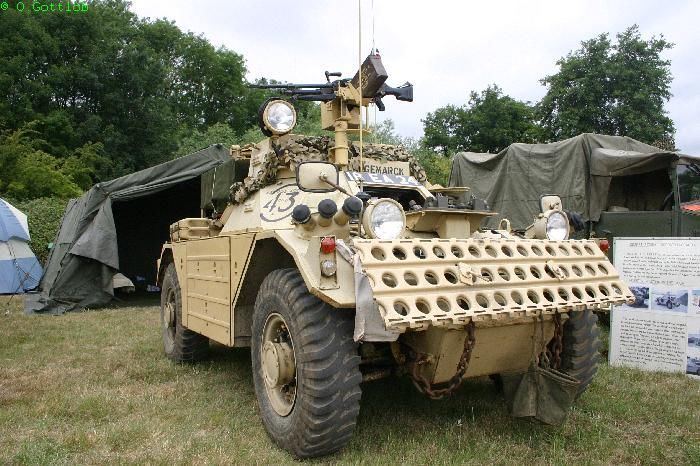Length 12 ft 2 in (3.7 m) Height 6 ft 2 in (1.88 m) | Weight 3.7 t Width 6 ft 3 in (1.91 m) | |
 | ||
Type Wheeled armoured fighting vehicle | ||
The Ferret armoured car, also commonly called the Ferret scout car, is a British armoured fighting vehicle designed and built for reconnaissance purposes. The Ferret was produced between 1952 and 1971 by the UK company Daimler. It was widely adopted by regiments in the British Army, as well as the RAF Regiment and Commonwealth countries throughout the period.
Contents
History
The Ferret was developed in 1949 as a result of a British Army requirement issued in 1947. 'Light reconnaissance cars' existed in during the Second World War, notably the Daimler Reconnaissance Scout Car.
Given its experience with the successful "Dingo" (6,626 produced and one of two British AFVs produced throughout WWII) the Daimler company was awarded a development contract in October 1948, and in June 1950 the first prototype of the Car, Scout, 4x4, Liaison (Ferret) Mark 1 was delivered.
Given the designation FV 701(C) it was one of several versions but the one that most closely resembled the original Daimler scout cars, and represented the basic model Ferret. This shared many similar design features with the Dingo, notably the H form drive train in which a central differential eliminates loss of traction due to wheel-slip, and parallel drive shafts considerably reduced the height of the vehicle (roughly equivalent to that of a tracked AFV), considerably reducing the vehicle's visual signature over conventional armoured car designs.
Like the Daimler scout car the Ferret suspension consisted of pairs of transverse links and single coil springs, the wheels driven by Tracta constant-velocity joints, but the Ferret benefited from epicyclic reduction gears that reduced transmission torque loads, essential given the more powerful six cylinder 4.26 litre water-cooled Rolls Royce B.60 petrol engine. Connected by a fluid coupling to a pre-selector five speed epicyclic gearbox, all gears being available in reverse, in its original form the Ferret this installation produced 116 bhp at 3,300 rpm and 129 bhp at 3,750 in its final form.
This improved power-to-weight ratio, longer wheelbase (2.29 m (7.5 ft) as compared with the Dingo's 1.98 metres (6.5 feet)) and the fitting of larger 9.00 x 16 run flat tyres both increased speed and mobility over broken ground.
When compared with the Daimler Dingo and Canadian Ford Lynx, the Ferret featured a larger fighting compartment, directly mounted to the hull (a feature that made the Ferret much noisier than Dingo, which lacked a fully monocoque body).
Constructed of 6–16 mm (0.24–0.63 in) steel plate protecting the crew from shell splinters at most angles except directly overhead, as the basic vehicle was open-topped and unarmed, with the exception of six forward-firing grenade launchers fitted to the hull over the front wheels (normally carrying smoke grenades), a feature found on all subsequent marks and models.
However, the Ferret normally carried a defensive fit of a .303in Bren light machine gun or pintle-mounted .30in Browning light machine gun in addition to the crew's personal weapons.
Ferret Mark 2
In contrast to the lightly armed and protected Mark 1, which could carry a .303in Bren or pintle-mounted .30in Browning light machine gun, the Mark 2 was designed from the outset to mount a .30in Browning in a one-man fully traversable turret, at the cost of one crew member. While this offered better crew protection and protected the otherwise dangerously exposed gunner, the turret raised the height of the vehicle and thus made it more conspicuous; in consequence the choice of fit depended on the nature of the mission.
In general terms the most successful wheeled armoured vehicles have been purpose-designed and the lightest, commensurate with their mission, being at the least disadvantage in relation to tracked vehicles in terms of ground pressure, which largely governs off-road performance.
Small and fast enough to be useful in an urban environment, but sufficiently strong and agile to negotiate rugged terrain off road, the Ferret, while no longer in service in the British Army, is still operated by several Commonwealth countries and has proven popular with private collectors due to the compact size and affordable price, e.g. around $20,000 to $30,000 in the United States, $40,000 to $60,000 in Australia and New Zealand and around $9,000 in the Czech Republic.
Mark 1 and Mark 2 Ferrets were used by Australian Military forces from 1953 to 1970, at which time Australian military forces disposed of them at public auction.
Production
A total of 4,409 Ferrets, including 16 sub-models under various Mark numbers, were manufactured between 1952 and 1962, when production ceased. It is possible to upgrade the engine using the more powerful FB60 version from the Austin Princess 4-Litre-R; this upgrade providing a 55bhp gain over the standard B60 engine.
Current operators
Former operators
Variants
There are several Marks of Ferret, including those with varying equipment, turret or no turret and armed with Swingfire anti-tank missiles. Including all the marks and experimental variants, there have probably been over 60 different vehicles.
